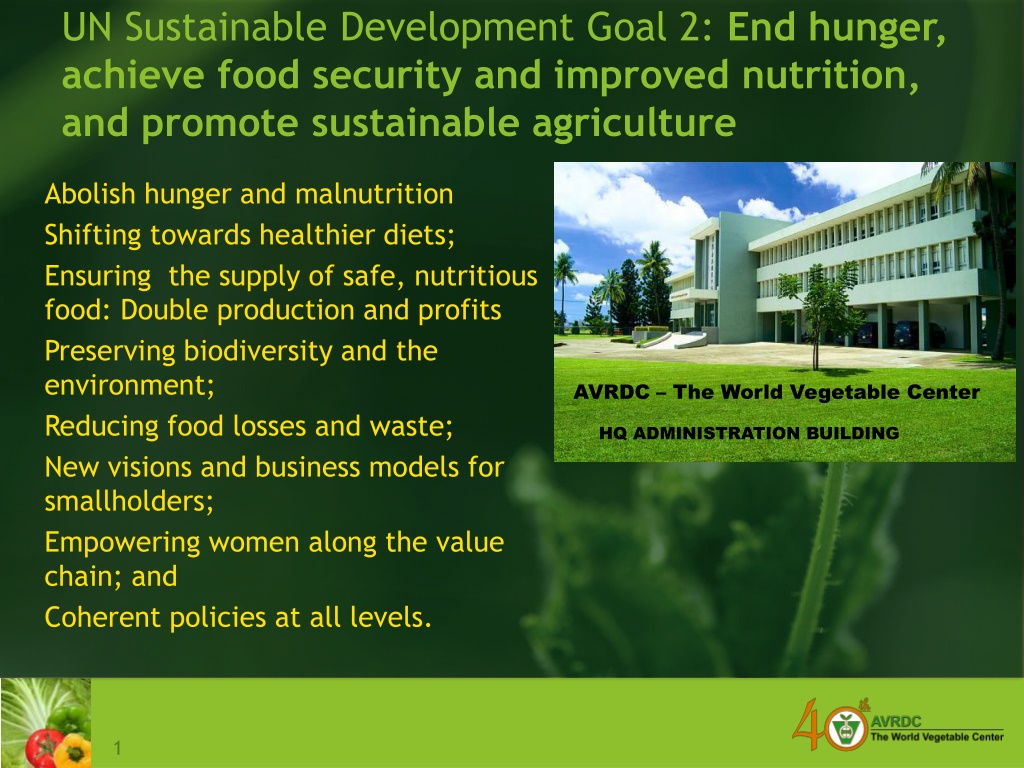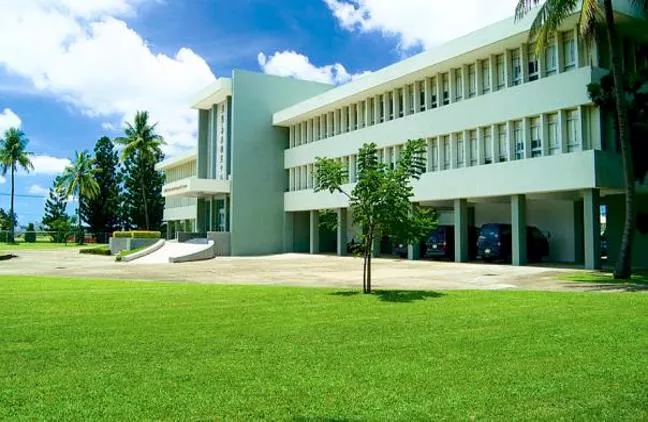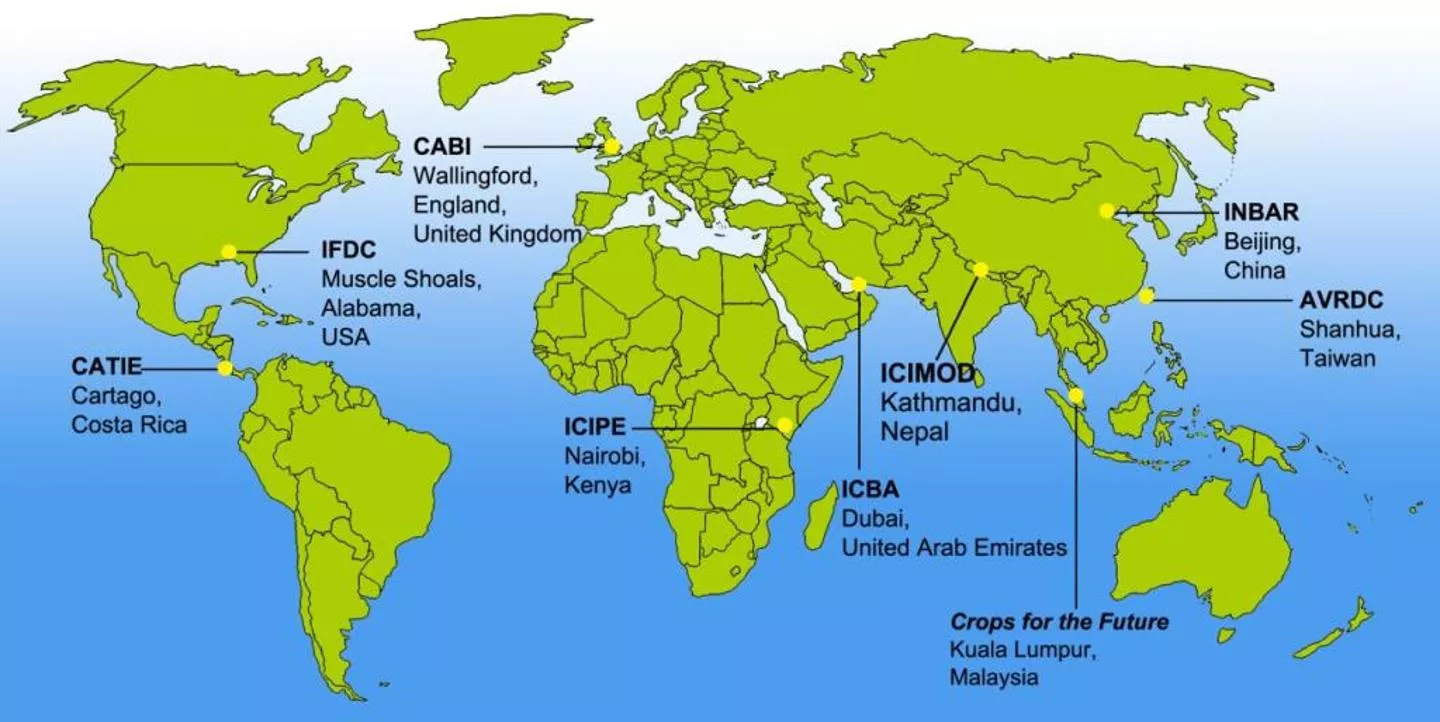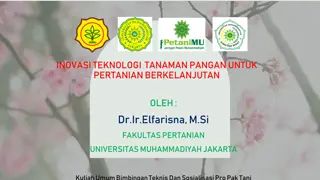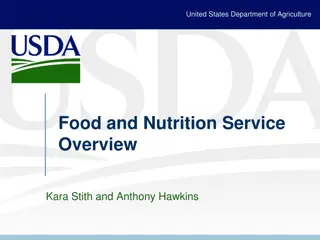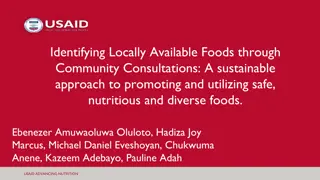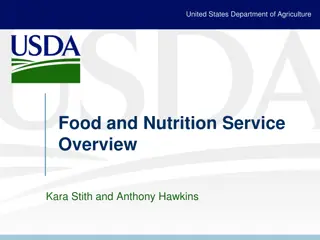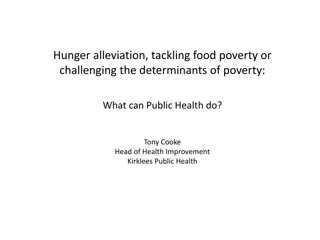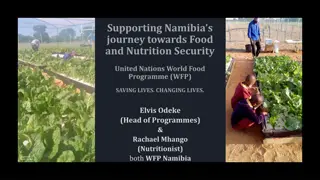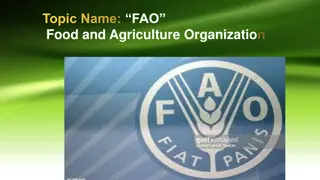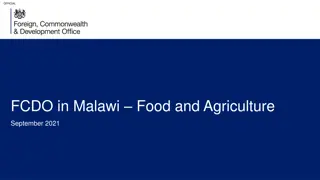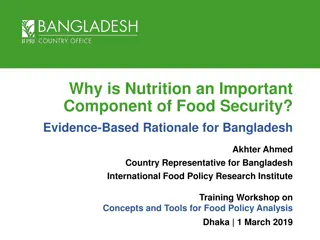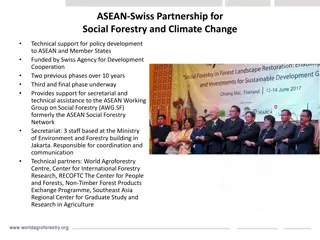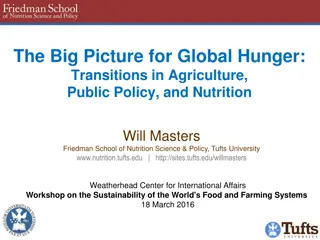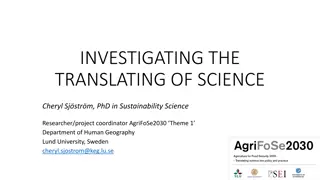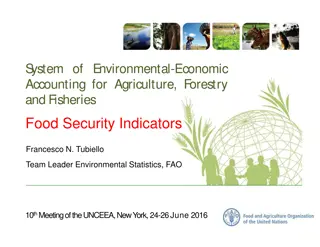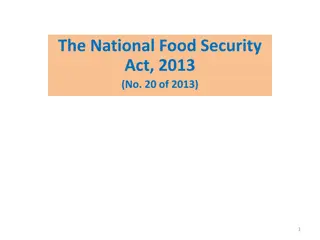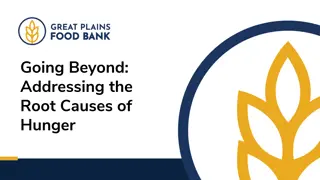Transforming Agriculture for Sustainable Development: Ending Hunger, Ensuring Food Security, and Promoting Nutrition
Sustainable Development Goal 2 focuses on ending hunger, achieving food security, and promoting sustainable agriculture. Initiatives include shifting towards healthier diets, ensuring safe and nutritious food supply, doubling production and profits, preserving biodiversity, reducing food waste, empowering women in agriculture, and implementing coherent policies. The World Vegetable Center advocates for diverse, nutrient-rich diets, promoting vegetable consumption through home and school gardens, food processing training, and providing information on raw vegetable nutrients for improved health and well-being.
Download Presentation

Please find below an Image/Link to download the presentation.
The content on the website is provided AS IS for your information and personal use only. It may not be sold, licensed, or shared on other websites without obtaining consent from the author. Download presentation by click this link. If you encounter any issues during the download, it is possible that the publisher has removed the file from their server.
E N D
Presentation Transcript
UN Sustainable Development Goal 2: End hunger, achieve food security and improved nutrition, and promote sustainable agriculture Abolish hunger and malnutrition Shifting towards healthier diets; Ensuring the supply of safe, nutritious food: Double production and profits Preserving biodiversity and the environment; Reducing food losses and waste; New visions and business models for smallholders; Empowering women along the value chain; and Coherent policies at all levels. AVRDC The World Vegetable Center HQ ADMINISTRATION BUILDING 1
2008 Association of International Research and Association of International Research and Development Centers for Agriculture (AIRCA) Development Centers for Agriculture (AIRCA) 2
Global expertise, local impact Central & West Asia and North Africa South Asia Headquarters West and Central Africa Central America Eastern and Southern Africa Oceania East & Southeast Asia www.avrdc.org
The world food supply is precariously reliant on a very small number of The world food supply is precariously reliant on a very small number of carbohydrate carbohydrate- -rich crops and the growing epidemic of malnutrition and non rich crops and the growing epidemic of malnutrition and non- - communicable diseases worldwide is bringing overwhelming health costs communicable diseases worldwide is bringing overwhelming health costs Is Feeding the World without Nourishing it at the same time sensible? Wheat, maize and rice supply more than 60% of humanity s Food and Nutrition Security is the key to overcoming malnutrition! Much higher rate of return to research in development opportunity crops and smallstock! Why not invest more in vegetables, fruits, fish, livestock and other agricultural products which can help to abolish malnutrition. Thus: We need to move beyond old Green Revolution thinking in both budget allocation and in Education! calories while other highly nutritious crops are underutilised
FRUIT & VEGETABLES more nutritious diets healthier children and adults more resilient individuals and households 200 g of each, daily = AVRDC The World Vegetable Center promotes vegetable consumption through Home and school gardens Recipes Food processing training HOW MUCH IS 400 GRAMS? RAW Nutrients in vegetables Improve children s ability to grow and learn Improve adults capacity to work and earn daily fruit & veg consumption = 400 g standard weight of football = 396 g COOKED
Why AVRDC Says Vegetables are Vital in dealing with emerging challenges and 1000 days program? 1000 days program? in promoting good health amongst poor, young, malnourished women and children
2008 Recommended nutrient intakes (RNI) and % RNI contributed from 100 gram of plant food Protein g 60 Vitamin A g RE 800 Iron mg 30 Folate g 600 Zinc mg 11 Calcium mg 1000 Vitamin E mg -TE 7.5 RNI for pregnant women (1st trimester) Percentage of RNI - - - - - - - - - - - - - - - - - - - - - % - - - - - - - - - - - - - - - - - - - - - - - - - - - - - Rice 0 0 Cassava (root) 2 0 Millet 6 0 Meat (chicken) 37 0 1 1 2 2 5 4 3 8 0 2 0 0 0 0 14 3 1 1 3 14 Mungbean Vegetable soybean Cabbage Tomato Slippery cabbage Moringa leaves Amaranth Jute mallow Nightshade Vegetable cowpea leaves` 40 18 3 2 6 7 9 10 8 8 2 2 1 18 106 146 160 198 101 193 22 13 1 1 5 11 6 12 13 6 104 28 10 3 30-177 49 31 21 10 27 24 13 2 2 11 5 6 0 9 3 13 4 4 1 18 10 32 36 21 54 7 78 2 7 58 65 17 36 28 101 RNI source: FAO/WHO 2004; RNI for iron with low bioavailability; RNI for zinc with medium bioavailability Nutrient data source: USDA nutrient database, AVRDC IV nutrient data, and literature 7
2008 The world s largest public sector collection of tropical vegetable germplasm No. of accessions No. of accessions No. of species 436 No. of species 436 No. of countries of origin 156 No. of countries of origin 156 62,000+ 62,000+ 8
Rijk Zwaan Afrisem Tanzania 75% of all seed companies in Asia sell varieties which include some germplasm originating from AVRDC. Mt. Kilimanjaro, Tanzania The % is much higher still in Africa Working with Enza Zaden and EW Seeds on virus control in Philippines, India and other countries in Asia AVRDC interacting globally with APSA and AFSTA
Economic impact of tomato grafting in Lam Dong province, Vietnam Parameter Lam Dong province Yield (t/ha) a Adoption rate Total profit (in million VND/ha) b Total area under tomato production (ha, 2011) c Total contribution of grafting (in million VND) Forex August 2012 average (VND/US$) Total contribution of grafting (million US$) 73.3 100% 30.0 6,388.0 191,640.0 20,703.4 9.3
Scaling and private seed companies Scaling and private seed companies Lal Teer Home garden seed packs are living advertisements Reduced TV advertising Aimed to sell 200,000 Actually sold over 1 million
The growing cost of obesity in Asia The growing cost of obesity in Asia- -Pacific This is a major problem in Asia and Oceania This is a major problem in Asia and Oceania Overweight and poor diets are becoming a greater burden for the Overweight and poor diets are becoming a greater burden for the poor than for the rich with spiraling health costs poor than for the rich with spiraling health costs The economic costs are 4 The economic costs are 4 8 percent of the economy 8 percent of the economy Pacific Popkin, B.(2008) Health Affairs, 27: 1064-1076 Diets including bitter Gourd may provide effective prophylaxis
Better resilience by reducing overall risks https://encrypted-tbn2.gstatic.com/images?q=tbn:ANd9GcSEGnEGf_5e8D_8_ANzRww4X01bWMtn0pCutCepZe1-NiibaCzI Prepare for Global Warming Now! 2025 is only one breeding, production and distribution cycle away 26.0 Y= -63.92 + 0.044X, R2=0.53, P<0.01, (n=39) Ave Temp Ave Temp - - AVRDC, Shanhua 1975 AVRDC, Shanhua 1975- -2013 2013 25.5 See Keatinge et al. 2013 and 2014 25.0 Ave temp oC Ave temp oC Insect & plant disease effects are coming! 24.5 24.0 23.5 4.4 oC increase Per 100 years 23.0 22.5 1975 1980 1985 1990 1995 Year Year 2000 2005 2010 2015 Variation in average annual air temperature (oC) at AVRDC, Shanhua, Taiwan 1975-2013
